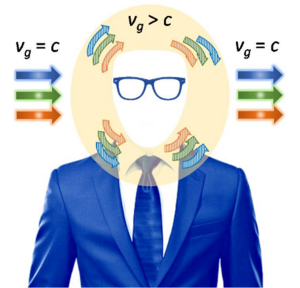
https://www.nature.com/articles/s41467-019-12813-2
Seeing the world around us is a fundamental aspect of human experience. We all use visible light – the part of the electromagnetic spectrum to which our eyes are most responsive – emitted by the sun to watch, appreciate and try to comprehend nature and the physical world around us.
Because light, and its interaction with our sensory system, our eyes, is an indispensable part of our everyday lives, we have been accustomed to always – ‘blindly’ – trust them. However, we also know from familiar experiences that this should not always necessarily be the case. A well-known example is desert mirages, where rays of light are refracted (bent) towards the lower, hotter layers of the air, causing visual illusions showing up as water-like images on the ground. We often notice that a road may appear wet or covered with puddles in the distance, on an especially sunny day – a phenomenon of the same origin as that causing fake desert oases.
Technologically, the ability to bend or tame the refraction and flow of light at will can have profound applications, not least in modern all-optical communication systems and stealth technology. However, for decades, scientists thought that the ultimate control over the flow of light, that is, hiding an object completely from incident visible light – thereby rendering the object invisible – was impossible. That notion changed more than a decade ago, around 2006, when it was established that suitably engineered coatings can actually render an arbitrary object invisible – but only across a very narrow range of light ‘colors’, i.e., over narrow bandwidths, especially for larger objects.
Now, an international team of scientists, led by Assistant Professor Kosmas L. Tsakmakidis of the Department of Physics of the National and Kapodistrian University of Athens, Greece, and co-supervised by Professors Hatice Altug of École Polytechnique Fédérale de Lausanne, Switzerland, and Robert W. Boyd of the University of Ottawa, Canada, report in a paper in Nature Communications that it is possible to make objects invisible over extremely large bandwidths, covering the entire visible spectrum.
“The key realization we arrived at was that to attain ultrabroadband invisibility we need to use cloaking layers made of media inside which some ‘colors’ or frequencies of light travel superluminally,” says Prof. Tsakmakidis. The researchers dub these invisibility cloaks “tachyonic,” meaning that inside them incident light pulses propagate with “group velocity” – the velocity with which the peak of the envelope of the light pulse propagates – faster, at some frequencies, than the speed of light in vacuum. “Such ‘fast-light’ media have extensively been studied in the recent past, but here we show that they can fruitfully be deployed for solving a key challenge of passive, that is, not time-varying, invisibility cloaks,” adds Prof. Tsakmakidis. “And strange as it might seems at first sight, they do not at all violate the theory of relativity which stipulates that signals cannot travel faster than the speed of light in vacuum. In fact, they can be realized using standard semiconductors technology, the same technology underpinning modern nanoelectronics – but now used for photons. However, for now, or scheme works only for small objects,” comments Prof. Tsakmakidis.
“Such an ultrabroadband invisibility technology is potentially more useful than existing stealth technology because it does not simply make an object ‘black’, preventing back-reflections, but allows light to be smoothly guided around the object, essentially ‘mapping’ the object to a single point – which is always invisible,” comments Prof. Altug. “The concept is completely scalable to other types of waves, too, such as acoustic or radar waves,” adds Prof. Altug.
Possible further applications include ‘invisible’ sensors that can detect changes in the surrounding environment without interfering with it, near-field scanning optical microscopes (NSOMs) with concealed tips for the minimally-disturbing imaging of nanoparticles, polymer blends, porous silicon and biological systems, electromagnetically camouflaged antennas, manipulation of mechanical, optical, sound and heat waves for information processing, satellite, heat-control and nanotechnology applications, as well as applications of fast light and superluminal propagation, including buffering, regeneration and time-windowing of optical data, ultrahigh-precision spectrometry and interferometry, rotation sensors based on laser gyros, and laser radars.
“It is perhaps another example of how fundamental, curiosity-driven research – in this case, within the field of ‘fast light’ –, which might at first sight seem disconnected or unrelated to the invisibility problem, can in fact creatively be linked to other fields of applied science and engineering, opening the path for a host of possible future applications,” remarks Prof. Boyd.
Professor Tsakmakidis’ research was supported by the Hellenic Foundation for Research & Innovation (HFRI – «ΕΛΙΔΕΚ»), and the General Secretariat of Research and Technology (GSRT - «ΓΓΕΤ»), through a three-year project fellowship aimed at exploring fundamental new concepts in the nascent fields of nanophotonics and metamaterials – the study of light at nanoscopic dimensions using artificially engineered optical media.